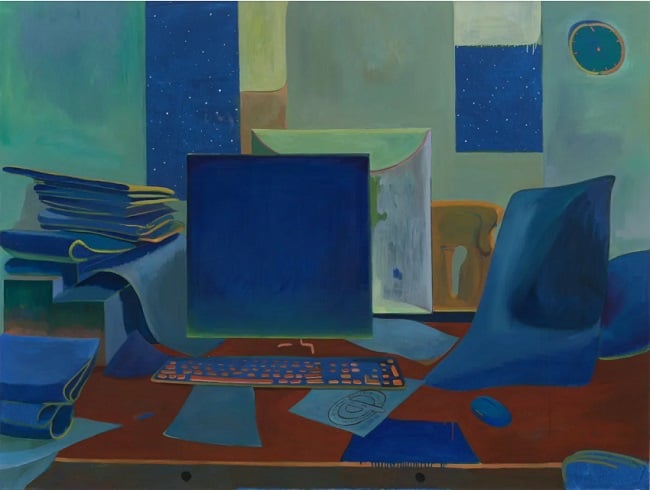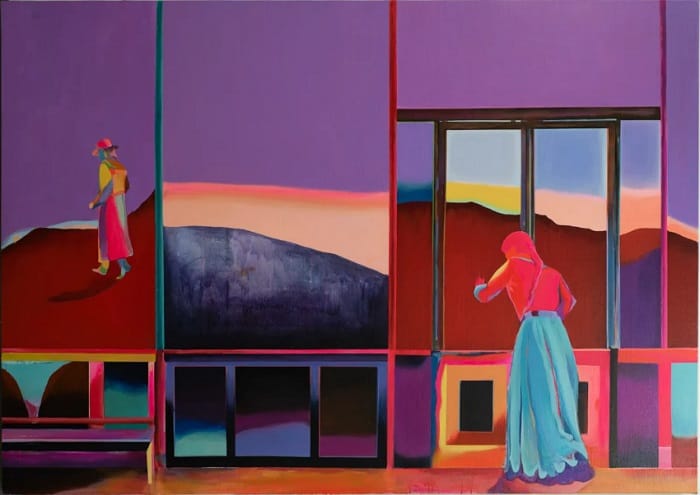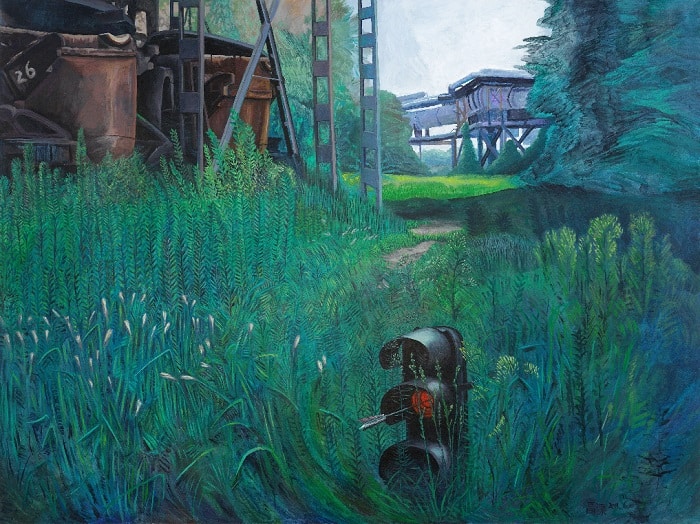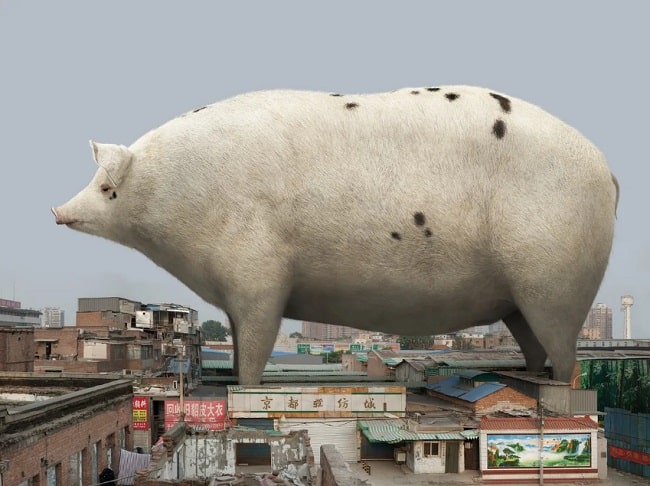Urban Country. A New VR Group Exhibition
“Urban Country” is a virtual group exhibition, featuring works by Zhai Liang, Zou Sijin, Lu Xinjian, Gao Yuan, Fu Wenjun, and Liu Di, in collaboration with five leading contemporary art galleries based in China—A Thousand Plateaus Art Space, ART LABOR Gallery, Capsule Shanghai, Independent Image Space and Migrant Bird Space.
In the face of the increasing phenomenon of urbanisation in countries such as China, the theme revolves around the complex relationship between city and country life. Many of the works depict settings that have both rural and urban elements, raising the question of whether these two seemingly polar opposite regions and lifestyles can coexist. Some urban scenes seem so freshly built, they still show remnants of the countryside. Other scenes show a lush countryside with city remnants, suggesting that the reverse development might have happened here.
“Urban Country” explores the differences and crossovers between what we understand as urban and what is rural. During uncertain times in the midst of a pandemic, the virtual exhibition also questions what we as human beings still consider a safe living environment – be it a city, the countryside or a completely virtual space online.
Featured Artists:
Zhai Liang 翟倞 (b.1983)

Zhai Liang graduated from the Sichuan Academy of Fine Arts and later from the Central Academy of Fine Arts in Beijing. His work is deeply concerned with literature, sociology and the power of painting itself.
His work Silence is Mystery takes a deserted urban office setting and creates a composition reminiscent of a still life or landscape painting, which is much more associated with a rural environment. The dormant computers resemble a city skyline at night.
In Rabbit, Run, Zhai Liang’s other work featured in the exhibition, the artist was inspired by several scenes from his favorite literature, in which the protagonists run for various reasons – be it to arrive at the next destination or to escape the current one. This crowd of busy people brings to mind the hurried lifestyle of metropolitan cities, in particular during rush hour. With the urgency of rabbits, each person seems to be running to the next destination.
Zou Sijin 邹思妗 (b.1986)

Zou Sijin graduated from the Oil Painting Department of Sichuan Fine Arts Academy. Her paintings often express a sense of detachment, showing a world in which the artist looks inward, while also constantly observing her surroundings.
The work Mountains Beyond Mountains was inspired by the fictional character Tereza in Milan Kundera’s novel “The Unbearable Lightness of Being.” The painting shows Tereza wandering through a troubled dream, in which her lover Tomas sends her to her death. In the novel, the couple eventually leaves the city to live in the countryside, hoping that the move away from an urban lifestyle will resolve their problems. The painting explores the idea of rural life as a means of refuge, whereas the urban world is portrayed as a set of cage-like frames from which to escape.
Gao Yuan 高源 (b.1986)

Gao Yuan was born in Kunming, Yunnan Province, and received her BA in Animation Arts in Beijing. Gao Yuan’s creation often starts from her own experiences. She is especially interested in the boundaries between dreams and reality and the perception of the self while dreaming.
The works Tribute to The Blow to the Heart II and Suspension are paintings that were integrated into Gao Yuan’s animation “Lunar Dial,” 2016.
Tribute to The Blow to the Heart II shows a mysterious, overgrown site, based on an actual former iron and steel factory in China. The surreal appearance of a traffic light looms out of the tall grass, still glowing red, despite being shot through by an arrow. This image, along with the title, is a direct reference to Magritte’s work “The Blow to the Heart,” which depicts a rose and a dagger. The rusty remnants of industrial constructs standing out of the lush landscape create a post-apocalyptic atmosphere, in which nature appears to have taken over a former urban setting.
Suspension shows more signs of an urban takeover. A wide street winds its way around a mountain that seems littered with debris – perhaps the remains of a village that had been torn down for the sake of urbanisation. The viewer is left to wonder where the road might be heading to and what might have existed before the road was built.
Lu Xinjian 陆新建 (b.1977)

Lu Xinjian was born and raised in a small tea village in rural China and has always been fascinated by the grand complex metropolitan areas of the world. He studied at the Design Academy Eindhoven and the Frank Mohr Institute in Holland. Coming from a design background and influenced by his own design practice, he brings his particular understanding of the relationships among lines, shapes and colors into his paintings.
“The City DNA” series looks at world capitals and significant urban layouts from an aerial view, using Google Earth and Google Maps as the starting point. The work is then drawn by hand in pen over the photo images and is then transferred in paint to the canvas in a very methodical and laborious process. The three works in “Urban Country” are depictions of the complexity of cities, yet at the same time, their rectangular patterns also resemble aerial views of rural land plots, blurring the lines between the rural and the urban.
Fu Wenjun 傅文俊 (b.1955)
Fu Wenjun (b. 1955), a graduate from Sichuan Fine Arts Institute, uses digital art, photography, installation, sculpture, oil painting, and mixed media, creating what he describes as “Digital Pictorial Photography” in the process.
His work Neighbors illustrates the artist’s reimagining of the city of Chongqing in Sichuan Province. Chongqing is a prime example of a city that has successfully transformed from a traditional industrial city to a modern metropolis. In the process, however, the city, formerly characterized by its traditional stilted buildings, gradually gave way to modern urban planning. Fu Wenjun spent several years capturing on camera the city’s remaining stilted buildings, most of which were about to be demolished. He then assembled these images into a 16-meter-long panorama, bringing together fragmented memories to create a nostalgic idea of a city, which stretches across the wall like an ancient scroll.
The work Birds Flying Overhead represents Fu Wenjun’s “Digital Pictorial Photography” – a unique style that places photography art in dialogue with other media, such as Chinese ink painting, oil painting, and sculpture. The work is part of the series “Misplacement”, which brings to mind the often dire consequences of resettling people from rural areas into cities, due to ambitious building projects.
Liu Di 柳迪 (b.1948)

Liu Di (b. 1948) studied in the Photography Department at the Central Academy of Fine Arts in Beijing and is known for his investigation of the friction between the natural world and urban residents in China through the means of digitally manipulated photographs.
The works in “Urban Country” are from Liu Di’s series “Animal Regulation.” These works show massive creatures set against urban backgrounds. Despite their size they retain the weak, domesticated look of zoo animals.
These surreal, almost comical images are expressions of the demise of traditional orders and social structures, lost during rapidly-developing urban environments. The artist’s giant humans and animals become symbols of disproportionate mutation, eroding people’s sense of structure in society and present-day life.
Relevant sources
Read an exclusive interview with Lu Xinjian
Explore Natural Magic, a VR group exhibition investigating contemporary presentations of nature, the ambiguity of mans’ conflicted relationship to it and his place within it.
